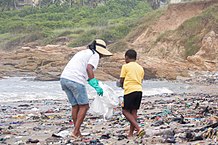Marine pollution
| Part of a series on |
| Pollution |
|---|
 |
Marine pollution occurs when substances used or spread by humans, such as
The types of marine pollution can be grouped as pollution from
Another concern is the runoff of
Many potentially toxic chemicals adhere to tiny particles which are then taken up by
can be transferred to land animals, and appear later in meat and dairy products.Pathways of pollution
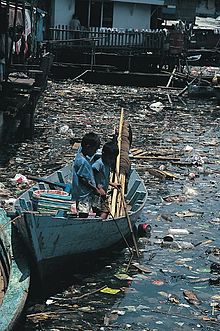
There are many ways to categorize and examine the inputs of pollution into marine ecosystems. There are three main types of inputs of pollution into the ocean: direct discharge of waste into the oceans, runoff into the waters due to rain, and pollutants released from the atmosphere.[6]
One common path of entry by
Pollution is often classed as point source or nonpoint source pollution. Point source pollution occurs when there is a single, identifiable, localized source of the pollution. An example is directly discharging sewage and industrial waste into the ocean. Pollution such as this occurs particularly in developing nations.[citation needed] Nonpoint source pollution occurs when the pollution is from ill-defined and diffuse sources. These can be difficult to regulate. Agricultural runoff and wind blown debris are prime examples.
Direct discharge

Pollutants enter rivers and the sea directly from urban sewerage and industrial waste discharges, sometimes in the form of hazardous and toxic wastes, or in the form of plastics.[citation needed]
In a study published by Science, Jambeck et al. (2015) estimated that the 10 largest emitters of oceanic plastic pollution worldwide are, from the most to the least, China, Indonesia, Philippines, Vietnam, Sri Lanka, Thailand, Egypt, Malaysia, Nigeria, and Bangladesh.[8]
Inland mining for copper, gold, etc., is another source of marine pollution. Most of the pollution is simply soil, which ends up in rivers flowing to the sea. However, some minerals discharged in the course of the mining can cause problems, such as copper, a common industrial pollutant, which can interfere with the life history and development of coral polyps.[9] Mining has a poor environmental track record. For example, according to the United States Environmental Protection Agency, mining has contaminated portions of the headwaters of over 40% of watersheds in the western continental US.[10] Much of this pollution finishes up in the sea.[citation needed]
Land runoff
Surface runoff from farming, as well as urban runoff and runoff from the construction of roads, buildings, ports, channels, and harbours, can carry soil and particles laden with carbon, nitrogen, phosphorus, and minerals. This nutrient-rich water can cause fleshy algae and phytoplankton to thrive in coastal areas; known as algal blooms, which have the potential to create hypoxic conditions by using all available oxygen. In the coast of southwest Florida, harmful algal blooms have existed for over 100 years.[11] These algal blooms have been a cause of species of fish, turtles, dolphins, and shrimp to die and cause harmful effects on humans who swim in the water.[11]
Polluted runoff from roads and highways can be a significant source of water pollution in coastal areas. About 75% of the toxic chemicals that flow into Puget Sound are carried by stormwater that runs off paved roads and driveways, rooftops, yards and other developed land.[12] In California, there are many rainstorms that runoff into the ocean. These rainstorms occur from October to March, and these runoff waters contain petroleum, heavy metals, pollutants from emissions, etc.[13]
In China, there is a large coastal population that pollutes the ocean through land runoff. This includes sewage discharge and pollution from urbanization and land use. In 2001, more than 66,795 mi2 of the Chinese coastal ocean waters were rated less than Class I of the Sea Water Quality Standard of China.[14] Much of this pollution came from Ag, Cu, Cd, Pb, As, DDT, PCBs, etc., which occurred from contamination through land runoff.[14]
Ship pollution

Ships can pollute waterways and oceans in many ways including through their ballast, bilge, and fuel tanks.
Oil spills are one of the most emotive of marine pollution events. However, while a tanker wreck may result in extensive newspaper headlines, much of the oil in the world's seas comes from other smaller sources, such as tankers discharging ballast water from oil tanks used on return ships, leaking pipelines or engine oil disposed of down sewers.[18]
Discharge of cargo residues from
Invasive species can take over once occupied areas, facilitate the spread of new diseases, introduce new genetic material, alter underwater seascapes, and jeopardize the ability of native species to obtain food. Invasive species are responsible for about $138 billion annually in lost revenue and management costs in the US alone.[23]
Atmospheric pollution
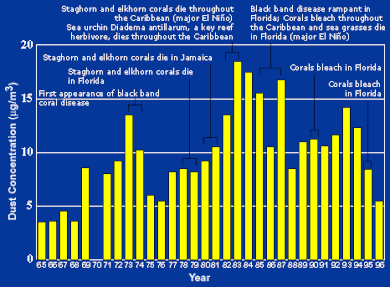
Another pathway of pollution occurs through the atmosphere. The ocean has long been affected by the passage of chemicals from the atmosphere (e.g. nutrient source; pH influence).
Since 1970, dust outbreaks have worsened due to periods of drought in Africa. There is a large variability in dust transport to the Caribbean and Florida from year to year;
Deep sea mining
Some of the potential toxic metals include copper, zinc, cadmium, lead as well as rare earth elements such as lanthanum and yttrium.[34] Following the release of toxins there is an increase of noise, light, sediment le dan plumes and elements that have the potential to impact the ecosystems.[35]
Deep sea minerals (DSM) can be extremely beneficial, it can cause wealth, raising living standards as well as economic opportunities for both current and future generations.
Types of pollution

Marine debris pollution

Plastic pollution

It is estimated that there is a stock of 86 million tons of plastic marine debris in the worldwide ocean as of the end of 2013, assuming that 1.4% of global plastics produced from 1950 to 2013 has entered the ocean and has accumulated there.
Oceans are polluted by plastic particles ranging in size from large original material such as bottles and bags, down to microplastics formed from the fragmentation of plastic material. This material is only very slowly degraded or removed from the ocean so plastic particles are now widespread throughout the surface ocean and are known to be having deleterious effects on marine life.
- Schmidt, Christian; Krauth, Tobias; Wagner, Stephan (11 October 2017). "Export of Plastic Debris by Rivers into the Sea" (PDF). PMID 29019247.
The 10 top-ranked rivers transport 88–95% of the global load into the sea
- "Supporting Information: Export of plastic debris by rivers into the sea" (PDF).[full citation needed]</ref>[58] Asia was the leading source of mismanaged plastic waste, with China alone accounting for 2.4 million metric tons.[59]
A study highlighted by the World Economic Forum warns that ocean plastic pollution could quadruple by 2050, with microplastics potentially increasing fiftyfold by 2100. The study highlighted the urgency of addressing plastic pollution, which threatens marine biodiversity and could push some species to the brink of extinction.[60]
Ocean acidification
A change in pH by 0.1 represents a 26% increase in hydrogen ion concentration in the world's oceans (the pH scale is logarithmic, so a change of one in pH units is equivalent to a tenfold change in hydrogen ion concentration). Sea-surface pH and carbonate saturation states vary depending on ocean depth and location. Colder and higher latitude waters are capable of absorbing more CO2. This can cause acidity to rise, lowering the pH and carbonate saturation levels in these areas. Other factors that influence the atmosphere-ocean CO2 exchange, and thus local ocean acidification, include: ocean currents and upwelling zones, proximity to large continental rivers, sea ice coverage, and atmospheric exchange with nitrogen and sulfur from fossil fuel burning and agriculture.[63][64][65]
Decreased ocean pH has a range of potentially harmful effects for marine organisms. These include reduced calcification, depressed metabolic rates, lowered immune responses, and reduced energy for basic functions such as reproduction.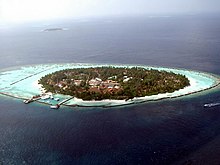
Nutrient pollution
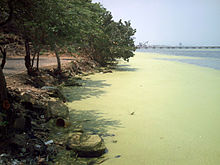
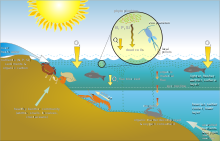
The biggest culprit are rivers that empty into the ocean, and with it the many chemicals used as fertilizers in agriculture as well as waste from livestock and humans. An excess of oxygen-depleting chemicals in the water can lead to hypoxia and the creation of a dead zone.[7]
In addition to
One proposed solution to eutrophication in estuaries is to restore shellfish populations, such as oysters. Oyster reefs remove nitrogen from the water column and filter out suspended solids, subsequently reducing the likelihood or extent of harmful algal blooms or anoxic conditions.[75] Filter feeding activity is considered beneficial to water quality[76] by controlling phytoplankton density and sequestering nutrients, which can be removed from the system through shellfish harvest, buried in the sediments, or lost through denitrification.[77][78] Foundational work toward the idea of improving marine water quality through shellfish cultivation to was conducted by Odd Lindahl et al., using mussels in Sweden.[79]
Toxicants
Apart from plastics, there are particular problems with other toxic pollutants that either do not break down or only very slowly in the marine environment. Examples of
DDT is a very toxic chemical that was used as a pesticide in mass quantities[80] throughout the United States and is known to be neurotoxic, a reproductive toxin, an endocrine disruptor, and a carcinogen.[81] DDT is a major focus of the book Silent Spring published by Rachel Carson in 1962. This is often attributed to launching the modern environmental movement[82] and setting the stage for the creation of the EPA in 1970.[83] DDT was banned in the U.S. two years later in 1972.[84] Unfortunately, large quantities had already entered the ocean through runoff and had been dumped directly into the ocean.[85] This toxin impacts marine ecosystems by accumulating from lower trophic levels[86] and up the food chain into higher trophic levels such as from arctic cod into seals,[87] from fish then eaten by dolphins,[88][89] and from cod and eels into seals.[90]
Shortly after Rachel Carson's publication of Silent Spring, PCBs were identified as another persistent, toxic chemical that has been released in extensive quantities to the environment. PCBs are a very well-studied class of chemicals that are manufactured from oil.[91] These chemicals are banned in the United States under the Toxic Substance Control Act,[92] but are still found in the soil, air, sediments, and biota.[91] PCBs are known to accumulate in the fatty tissues of animals. In particular, PCBs build up and are stored in the blubber of marine mammals including dolphins and killer whales.[93] These chemicals cause reproductive issues for many species.[93] In mud crabs, PCBs have been discovered to be immunotoxic by reducing resistance to bacterial disease, reducing antioxidant enzyme activity, and damaging DNA responsible for immune system functions.[94]
PFAS are an important emerging class of man-made persistent toxicants that contain extremely strong carbon-fluorine bonds which make these chemicals extremely difficult to break down. They have unique properties that make them useful for manufacturing a wide variety of products such as firefighting foams, clothing, carpets, and fast food wrappers.[95] These useful properties in manufacturing unfortunately translate to problematic properties in the environment and organisms from plants to people. Because PFAS are not broken down in the environment, they have been circulated through the air and water to essentially all regions of the atmosphere, land, and ocean.[96][97] These chemicals have many negative effects on marine life, such as significantly inhibited growth of phytoplankton over time[98] and accumulation in seals, polar bears,[99] and dolphins.[100] Current research is underway investigating the full extent of the harm to marine ecosystems caused by PFAS.
- Specific examples
- Chinese and Russian industrial pollution such as
- Acute and chronic pollution events have been shown to impact southern California kelp forests, though the intensity of the impact seems to depend on both the nature of the contaminants and duration of exposure.[102][103][104][105][106]
- Due to their high position in the food chain and the subsequent accumulation of heavy metals from their diet, mercury levels can be high in larger species such as bluefin and albacore. As a result, in March 2004 the United States FDA issued guidelines recommending that pregnant women, nursing mothers and children limit their intake of tuna and other types of predatory fish.[107]
- Some shellfish and crabs can survive polluted environments, accumulating heavy metals or toxins in their tissues. For example,
- Surface runoff of pesticides can alter the gender of fish species genetically, transforming male into female fish.[111]
- Heavy metals enter the environment through oil spills – such as the Prestige oil spill on the Galician coast and Gulf of Mexico which unleashed an estimated 3.19 million barrels of oil[112] – or from other natural or anthropogenic sources.
- In 2005, the 'Ndrangheta, an Italian mafia syndicate, was accused of sinking at least 30 ships loaded with toxic waste, much of it radioactive. This has led to widespread investigations into radioactive waste disposal rackets.[113]
- Since the end of World War II, various nations, including the Soviet Union, the United Kingdom, the United States, and Germany, have disposed of chemical weapons in the Baltic Sea, raising concerns of environmental contamination.[114][115]
- The Fukushima Daiichi nuclear disaster in 2011 caused radioactive toxins from the damaged power plant to leak into the air and ocean. There are still many isotopes in the ocean, which directly affects the benthic food web and also affects the whole food chain. The concentration of 137Cs in the bottom sediment that was contaminated by water with high concentrations in April–May 2011 remains quite high and is showing signs of very slow decrease with time.[116]
- During the 20th century, large amounts of DDT, petroleum products, radioactive materials, sulphuric acid, and other toxins were dumped in the Pacific Ocean off the coast of Southern California.
Underwater noise
Marine life can be susceptible to noise or the sound pollution from sources such as passing ships, oil exploration seismic surveys, and naval low-frequency active
Noise also makes species communicate louder, which is called the Lombard vocal response.
According to the oceanographer Sylvia Earle, "Undersea noise pollution is like the death of a thousand cuts. Each sound in itself may not be a matter of critical concern, but taken all together, the noise from shipping, seismic surveys, and military activity is creating a totally different environment than existed even 50 years ago. That high level of noise is bound to have a hard, sweeping impact on life in the sea."[122]
Noise from ships and human activity can damage Cnidarians and Ctenophora, which are very important organisms in the marine ecosystem. They promote high diversity and they are used as models for ecology and biology because of their simple structures. When there is underwater noise, the vibrations in the water damage the cilia hairs in the Coelenterates. In a study, the organisms were exposed to sound waves for different numbers of times and the results showed that damaged hair cells were extruded or missing or presented bent, flaccid or missed kinocilia and stereocilia.[123] Ships can be certified to meet certain noise criteria.[124]
Other
There are a variety of secondary effects stemming not from the original pollutant, but a derivative condition. An example is silt-bearing surface runoff, which can inhibit the penetration of sunlight through the water column, hampering photosynthesis in aquatic plants.[125]
Mitigation
Much
Bjorn Jennssen (2003) notes in his article, "Anthropogenic pollution may reduce biodiversity and productivity of marine ecosystems, resulting in reduction and depletion of human marine food resources".[127] There are two ways the overall level of this pollution can be mitigated: either the human population is reduced, or a way is found to reduce the ecological footprint left behind by the average human. If the second way is not adopted, then the first way may be imposed as the world ecosystems falter.[citation needed]
The second way is for humans, individually, to pollute less. That requires social and political will, together with a shift in awareness so more people respect the environment and are less disposed to abuse it.[128] At an operational level, regulations, and international government participation is needed.[129] It is often very difficult to regulate marine pollution because pollution spreads over international barriers, thus making regulations hard to create as well as enforce.[130]
Without appropriate awareness of marine pollution, the necessary global will to effectively address the issues may prove inadequate. Balanced information on the sources and harmful effects of marine pollution need to become part of general public awareness, and ongoing research is required to fully establish, and keep current, the scope of the issues. As expressed in Daoji and Dag's research,[131] one of the reasons why environmental concern is lacking among the Chinese is because the public awareness is low and therefore should be targeted.[citation needed]

The amount of awareness on marine pollution is vital to the support of keeping the prevention of trash from entering waterways and ending up in our oceans. The EPA reports that in 2014 Americans generated about 258 million tons of waste, and only a third was recycled or composted. In 2015, there was over 8 million tons of plastic that made it into the ocean. The Ocean Conservancy reported that China, Indonesia, Philippines, Thailand, and Vietnam dump more plastic in the sea than all other countries combined.[132] Through more sustainable packing this could lead to; eliminating toxic constituents, using fewer materials, making more readily available recyclable plastic. However, awareness can only take these initiatives so far. The most abundant plastic is PET (Polyethylene terephthalate) and is the most resistant to biodegradables. Researchers have been making great strides in combating this problem. In one way has been by adding a special polymer called a tetrablock copolymer. The tetrablock copolymer acts as a laminate between the PE and iPP which enables for an easier breakdown but still be tough. Through more awareness, individuals will become more cognizant of their carbon footprints. Also, from research and technology, more strides can be made to aid in the plastic pollution problem.[133][134]Jellyfish have been considered a potential mitigating organism for pollution.[135][136]
Global goals
In 2017, the United Nations adopted a resolution establishing Sustainable Development Goals, including reduced marine pollution as a measured goal under Goal 14. The international community has agreed that reducing pollution in the oceans is a priority, which is tracked as part of Sustainable Development Goal 14 which actively seeks to undo these human impacts on the oceans.[137] The title of Target 14.1 is: "By 2025, prevent and significantly reduce marine pollution of all kinds, in particular from land-based activities, including marine debris and nutrient pollution."[137]
History
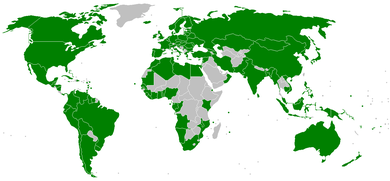
Although marine pollution has a long history, significant international laws to counter it were not enacted until the twentieth century. Marine pollution was a concern during several United Nations Conventions on the Law of the Sea beginning in the 1950s. Most scientists believed that the oceans were so vast that they had unlimited ability to dilute, and thus render pollution harmless.[citation needed]
In the late 1950s and early 1960s, there were several controversies about dumping radioactive waste off the coasts of the United States by companies licensed by the
Marine pollution was a major area of discussion during the 1972
Society and culture
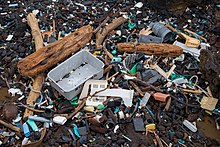
Laws and policies
There are different ways for the ocean to get polluted, therefore there have been multiple laws, policies, and treaties put into place throughout history. In order to protect the ocean from marine pollution, policies have been developed internationally.
- In 1948, Harry Truman signed a law formerly known as the Federal Water Pollution Control Act[139] that allowed the federal government to control marine pollution in United States of America.
- In 1972, the Marine Protection, Research, and Sanctuaries Act of 1972 (MPRSA) was passed by the United States Congress, and regulates ocean dumping of waste in US waters.[140][141]
- The 1954 Convention for the Prevention of Pollution of the Sea by Oil and the 1973 International Convention for the Prevention of Pollution by Ships were weakly enforced due to a lack of respect for the laws from flag states.[142]
- In 1973 and 1978, MARPOL 73/78 was a treaty written to control vessel pollution, especially regarding oil. In 1983, the International Convention for the Prevention of Pollution from Ships enforced the MARPOL 73/78 treaty internationally.[143]
- The 1982 United Nations Convention on the Law of the Sea (UNCLOS) was established to protect the marine environment by governing states to control their pollution to the ocean. It put restrictions on the amount of toxins and pollutants that come from all ships internationally.[144]
- In 2006, the Marine Debris Research, Prevention and Reduction Ac.[145] It was established by the National Oceanic and Atmospheric Administration (NOAA) to help identify, determine the source of, reduce and prevent marine debris.
- In December 2017, the UN Environmental Agency (UNEA) established the Ad Hoc Open-Ended Expert Group on Marine Litter and Microplastics with the purpose of examining marine plastic pollutions and to evaluate ways to handle the issue.[146]
See also
- Aquatic toxicology
- Environmental impact of pesticides
- Mercury pollution in the ocean
- Oil pollution toxicity to marine fish
- Plasticosis
- Stockholm Convention on Persistent Organic Pollutants
- Sea snot
- World Oceans Day
References
- OCLC 1052566532.
- ^ "Marine Pollution". Education | National Geographic Society. Retrieved 19 June 2023.
- ^ Duce, Robert; Galloway, J.; Liss, P. (2009). "The Impacts of Atmospheric Deposition to the Ocean on Marine Ecosystems and Climate WMO Bulletin Vol 58 (1)". Archived from the original on 18 December 2023. Retrieved 22 September 2020.
- ^ "What is the biggest source of pollution in the ocean?". National Ocean Service (US). Silver Spring, MD: National Oceanic and Atmospheric Administration. Retrieved 21 September 2022.
- PMID 29301986.
- ^ Patin, S.A. "Anthropogenic impact in the sea and marine pollution". offshore-environment.com. Retrieved 1 February 2018.
- ^ a b Gerlach, S. A. (1975) Marine Pollution, Springer, Berlin
- S2CID 206562155.
- ^ Young, Emma (18 November 2003). "Copper decimates coral reef spawning". London: New Scientist.
- ^ "Liquid Assets 2000: Americans Pay for Dirty Water". U.S. Environmental Protection Agency (EPA). Archived from the original on 15 May 2008. Retrieved 23 January 2007.
- ^ JSTOR j.ctt5hj4c2.10.
- ^ "Control of Toxic Chemicals in Puget Sound, Phase 2: Development of Simple Numerical Models". Washington State Department of Ecology. 2008. Archived from the original on 2 March 2017.
- PMID 28238485.
- ^ S2CID 12289116.
- ^ Panetta, L.E. (Chair) (2003). America's living oceans: charting a course for sea change (PDF). Pew Oceans Commission. p. 64.
- ISSN 2296-7745.
- ^ "Bilge dumping: Illegal pollution you've never heard of – DW – 04/28/2022". dw.com. Retrieved 29 March 2023.
- ISBN 978-0-415-14515-2.[page needed]
- ^ Schulkin, Andrew (2002). "Safe harbors: Crafting an international solution to cruise ship pollution". Georgetown International Environmental Law Review. 15 (1): 105–132.
- ^ Podsadam, Janice (19 June 2001). "Lost Sea Cargo: Beach Bounty or Junk?". National Geographic News. Archived from the original on 3 July 2001. Retrieved 8 April 2008.
- ^ a b Meinesz, A. (2003) Deep Sea Invasion: The Impact of Invasive Species PBS: NOVA. Retrieved 26 November 2009
- ^ Aquatic invasive species. A Guide to Least-Wanted Aquatic Organisms of the Pacific Northwest Archived 25 July 2008 at the Wayback Machine. 2001. University of Washington
- .
- US Geological Survey. Retrieved 10 December 2009
- ^ "The Impacts of Atmospheric Deposition to the Ocean on Marine Ecosystems and Climate". public.wmo.int. 12 November 2015. Archived from the original on 18 December 2023. Retrieved 11 August 2022.
- S2CID 30337924.
- ^ Usinfo.state.gov. Study Says African Dust Affects Climate in U.S., Caribbean. Archived 20 June 2007 at the Wayback Machine. Retrieved 10 June 2007
- S2CID 33094175.
- U. S. Geological Survey. Coral Mortality and African Dust. Archived 2 May 2012 at the Wayback Machine. Retrieved 10 June 2007
- ^ Observations: Oceanic Climate Change and Sea Level Archived 13 May 2017 at the Wayback Machine In: Climate Change 2007: The Physical Science Basis. Contribution of Working Group I to the Fourth Assessment Report of the Intergovernmental Panel on Climate Change. (15MB)
- ^ Doney, S. C. (2006) "The Dangers of Ocean Acidification" Scientific American, March 2006
- ^ Cheung, W.W.L., et al. (2009) "Redistribution of Fish Catch by Climate Change. A Summary of a New Scientific Analysis Archived 26 July 2011 at the Wayback Machine" Pew Ocean Science Series
- ^ PACFA Archived 15 December 2009 at the Wayback Machine (2009) Fisheries and Aquaculture in a Changing Climate
- ISSN 2296-7745.
- S2CID 52945921.
- ^ S2CID 111380724.
- ^ Graham, Rachel (10 July 2019). "Euronews Living | Watch: Italy's answer to the problem with plastic". living.
- ^ "Dumped fishing gear is biggest plastic polluter in ocean, finds report". The Guardian. 6 November 2019. Retrieved 9 April 2021.
- ^ "Facts about marine debris". US NOAA. Archived from the original on 13 February 2009. Retrieved 10 April 2008.
- ISBN 978-0312347291.
- ^ "Marine plastic pollution". IUCN. November 2021. Retrieved 27 May 2023.
- ^ "Nanoplastics in snow: The extensive impact of plastic pollution". Open Access Government. 26 January 2022. Retrieved 1 February 2022.
- .
- ^ "The average person eats thousands of plastic particles every year, study finds". Environment. 5 June 2019. Archived from the original on 17 February 2021. Retrieved 17 March 2023.
- ^ a b Microplastics and Micropollutants in Water: Contaminants of Emerging Concern (Report). European Investment Bank. 27 February 2023.
- S2CID 246672629.
- S2CID 252251921.
- ^ "Drowning in Plastics – Marine Litter and Plastic Waste Vital Graphics". UNEP – UN Environment Programme. 21 October 2021. Retrieved 21 March 2022.
- ^ Wright, Pam (6 June 2017). "UN Ocean Conference: Plastics Dumped In Oceans Could Outweigh Fish by 2050, Secretary-General Says". The Weather Channel. Retrieved 5 May 2018.
- PMID 30992426.
- ^ "Research | AMRF/ORV Alguita Research Projects". Algalita Marine Research Foundation. Archived from the original on 4 May 2009. Retrieved 19 May 2009.
- ^ "Marine Litter: An Analytical Overview" (PDF). United Nations Environment Programme. 2005. Archived from the original (PDF) on 12 July 2008. Retrieved 1 August 2008.
- ^ "Six pack rings hazard to wildlife". helpwildlife.com. Archived from the original on 13 May 2008.
- ^ "Marine Litter: More Than A Mess". Fact Sheets. Louisiana Fisheries. Retrieved 18 April 2023.
- ^ "'Ghost fishing' killing seabirds". BBC News. 28 June 2007.
- PMID 29628159.
- .
- ^ Harald Franzen (30 November 2017). "Almost all plastic in the ocean comes from just 10 rivers". Deutsche Welle. Retrieved 18 December 2018.
It turns out that about 90 percent of all the plastic that reaches the world's oceans gets flushed through just 10 rivers: The Yangtze, the Indus, Yellow River, Hai River, the Nile, the Ganges, Pearl River, Amur River, the Niger, and the Mekong (in that order).
- ^ Hotz, Robert Lee (13 February 2015). "Asia Leads World in Dumping Plastic in Seas". The Wall Street Journal. Archived from the original on 23 February 2015.
- ^ "Ocean plastic pollution threatens marine extinction says new study".
- S2CID 255431338.
Figure 1f
- ISBN 0-85403-617-2.
- PMID 31819102.
 Text was copied from this source, which is available under a Creative Commons Attribution 4.0 International License Archived 16 October 2017 at the Wayback Machine
Text was copied from this source, which is available under a Creative Commons Attribution 4.0 International License Archived 16 October 2017 at the Wayback Machine - S2CID 214271838.
- S2CID 221369828.
- PMID 18988740.
- ^ Cornelia Dean (30 January 2009). "Rising Acidity Is Threatening Food Web of Oceans, Science Panel Says". New York Times.
- PMID 22798578.
- ^ Coral reefs around the world The Guardian, 2 September 2009
- S2CID 235364600.
- ^ Selman, Mindy (2007) Eutrophication: An Overview of Status, Trends, Policies, and Strategies. World Resources Institute
- ^ "The Gulf of Mexico Dead Zone and Red Tides". Retrieved 27 December 2006.
- S2CID 11204131.
- ^ Addressing the nitrogen cascade Eureka Alert, 2008
- ^ Kroeger, Timm (May 2012). "Dollars and Sense: Economic Benefits and Impacts from two Oyster Reef Restoration Projects in the Northern Gulf of Mexico". The Nature Conservancy.
- ^ Burkholder, JoAnn M. and Shumway, Sandra E. (2011). "Bivalve shellfish aquaculture and eutrophication". In: Shellfish Aquaculture and the Environment. Ed. Sandra E. Shumway. John Wiley & Sons
- S2CID 83551118.
- S2CID 6589732.
- S2CID 25371433.
- ^ "DDT Regulatory History: A Brief Survey (to 1975)". United States Environmental Protection Agency. July 1975. Retrieved 10 November 2023.
- PMID 26977256.
- ^ "Legacy of Rachel Carsons Silent Spring National Historic Chemical Landmark". American Chemical Society. Retrieved 10 November 2023.
- ^ "How Rachel Carson's 'Silent Spring' Awakened the World to Environmental Peril". HISTORY. 22 April 2022. Retrieved 10 November 2023.
- ^ "Dichlorodiphenyltrichloroethane (DDT) Factsheet | National Biomonitoring Program | CDC". www.cdc.gov. 2 September 2021. Retrieved 10 November 2023.
- ^ "Chemical Dumpsite Offshore Southern California". scripps.ucsd.edu. 26 September 2022. Retrieved 10 November 2023.
- PMID 15862399.
- PMID 22148662.
- .
- S2CID 85012745.
- ISSN 0141-1136.
- ^ PMID 35878270.
- ^ "Toxic Substances Control Act (TSCA) and Federal Facilities". United States Environmental Protection Agency. 8 August 2023. Retrieved 10 November 2023.
- ^ PMID 26766430.
- S2CID 238218223.
- PMID 36652110.
- PMID 35202231.
- S2CID 232090620.
- S2CID 171092231.
- S2CID 195764669.
- S2CID 238258920.
- ^ "Indigenous Peoples of the Russian North, Siberia and Far East: Nivkh" by Arctic Network for the Support of the Indigenous Peoples of the Russian Arctic
- ^ Grigg, R.W.; Kiwala, R.S. (1970). "Some ecological effects of discharged wastes on marine life". California Department of Fish and Game. 56: 145–155.
- S2CID 111153399.
- ISBN 978-94-010-4882-8.
- .
- hdl:1808/16724.
- ^ "Advice about Eating Fish For Women Who Are or Might Become Pregnant, Breastfeeding Mothers, and Young Children". FDA. 24 February 2020.
- ^ Gollasch, Stephen (3 March 2006). "Ecology of Eriocheir sinensis".
- PMID 15519723.
- PMID 14720604.
- ^ Saey, Tina Hesman (12 August 2002). "DDT treatment turns male fish into mothers". Science News.
- ^ "Gulf Oil Spill". Smithsonian Ocean. 30 April 2018.
- ^ Bocca, Riccardo (5 August 2005) Parla un boss: Così lo Stato pagava la 'ndrangheta per smaltire i rifiuti tossici. L'Espresso
- ^ "Chemical Weapon Time Bomb Ticks in the Baltic Sea". DW. 1 February 2008.
- ^ "Activities 2007 Overview" (PDF). Baltic Sea Environment Proceedings No. 112. Helsinki Commission.
- .
- ^ Noise pollution Archived 7 December 2016 at the Wayback Machine Sea.org. Retrieved 24 October 2009
- ^ Ross, (1993) On Ocean Underwater Ambient Noise. Institute of Acoustics Bulletin, St Albans, Herts, UK: Institute of Acoustics, 18
- ^ Glossary Archived 29 June 2017 at the Wayback Machine Discovery of Sounds in the Sea. Retrieved 23 December 2009
- PMID 12822811.
- ^ Effects of Sound on Marine Animals Archived 13 January 2010 at the Wayback Machine Discovery of Sounds in the Sea. Retrieved 23 December 2009
- ^ Natural Resources Defense Council Press Release (1999) Sounding the Depths: Supertankers, Sonar, and the Rise of Undersea Noise, Executive Summary. New York, N.Y.: www.nrdc.org
- PMID 28000727.
- ^ "HSHI Delivers World's First Product Carrier With 'SILENT-E' Underwater Noise Notation". www.marineinsight.com. 19 April 2021.
- ^ Queensland Government (13 February 2019). "How does sediment affect the Great Barrier Reef?". Reef 2050 Water Quality Improvement Plan. Retrieved 4 August 2021.
- ^ Fertilizer and plastic pollution are the main emerging issues in 2011 UNEP Year Book Archived 15 June 2015 at the Library of Congress Web Archives, 17 February 2011. News Centre, United Nations Environment Programme, The Hague
- PMID 12676633.
- .
- .
- ISBN 978-90-04-17262-3.[page needed]
- S2CID 12289116.
- ^ Leung, Hannah (21 April 2018). "Five Asian Countries Dump More Plastic Into Oceans Than Anyone Else Combined: How You Can Help". Forbes.
China, Indonesia, Philippines, Thailand, and Vietnam are dumping more plastic into oceans than the rest of the world combined, according to a 2017 report by Ocean Conservancy
- PMID 29666242.
- ^ "Trash Free Waters". EPA. 15 September 2022.
- ^ Fourneris, Cyril (20 January 2020). "Could jellyfish be the answer to fighting ocean pollution?". euronews.
- ^ "GoJelly; a gelatinous solution to plastic pollution". Odense, Denmark: SDU University of Southern Denmark. Retrieved 21 September 2022.
- ^ a b United Nations (2017) Resolution adopted by the General Assembly on 6 July 2017, Work of the Statistical Commission pertaining to the 2030 Agenda for Sustainable Development (A/RES/71/313)
- ISBN 978-0-8135-4220-1.
- ISBN 978-1-135-89166-4.[page needed]
- ^ "Learn About Ocean Dumping". EPA. 8 June 2022.
- JSTOR 42842563.
- S2CID 40130385.
- JSTOR 20644564.
- JSTOR 40923485.
- OCLC 700946101.
- S2CID 225630731.
Further reading
- Dunning, Brian (16 December 2008). "Skeptoid #132: The Sargasso Sea and the Pacific Garbage Patch". Skeptoid.


